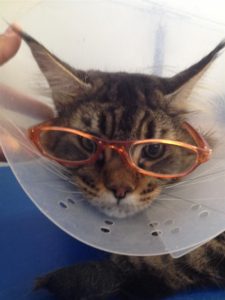Cat Scratching Got You Fevered?
You probably know why your cat is scratching up the furniture – it helps sharpen her claws, and it’s also a way of stretching her muscles. But knowing the reasons your cat shreds your belongings doesn’t make it any easier to deal with when your furry friend is ruining the furniture. This week’s blog post addresses what pet owners can do to deal with the cat scratching problem.
Declawing
Let’s start with a dramatic solution that I hope you aren’t seriously considering: declawing your pet cat. The process involves amputation of the cat’s claws, which has to be traumatic, but even worse, it puts them at risk for the rest of their life. If they are ever again on their own outdoors, they won’t be able to defend themselves, or hunt for food. Let’s move on to kinder, if less permanent, options.
Scratching Posts
Scratching and claw sharpening are normal instincts for cats, so punishing the cat for doing what comes naturally isn’t likely to be too effective. Instead, try buying a scratching post and redirecting your cat’s attention away from your furniture, and toward this new object. You may need to experiment to find a scratching post made of the material that your cat most likes to scratch; it will be easier to train him if he is attracted with the material. Sisal, carpet, and corrugated cardboard seem to be popular. If possible, place the post on top of the affected area rather than on the floor. This will help your cat become interested in and familiar with it. Leave the post in this (probably inconvenient) spot until he notices it and even tries it out, and then gradually move it to another area as the cat gets used to it.

Nail Trims
Trimming your cat’s nails regularly is another humane way to reduce scratching trauma in your household. Trimming blunts the cat’s nails, making it harder for them to tear up your upholstery. Be careful when trimming not to cut the claws to the quick, as blood vessels do run through them. If you aren’t comfortable trimming your cat’s nails yourself, have a pet groomer do it or ask them to show you how to do it yourself.
Nail Caps
Another option is to have plastic nail caps (such as Soft Claws) adhered to your cat’s claws. Nail caps for cats are usually clear, but can be colored as seen on the kitty pictured at right. Nail caps are quite effective at cutting down on scratching, but are also quite high maintenance. The caps must be reapplied regularly as they fall off as the nails grow out. Your cat will have an adjustment period of getting used to them, and so will you. Due to the way cat nails grow, expect a few of the caps to fall off shortly after the initial application. It’s not a failure of the glue, it’s the outer layer of the nail itself that debonds – a process that occurs naturally and is not uncomfortable for the cat. As you replace nail caps regularly, you’ll find they have much better staying power.
Wear Him Out
Finally, try getting your cat a few toys and playing with him regularly. The exercise will be good for him, and may even help distract him from your sofa. Or at least maybe he’ll spend more time sleeping and less time clawing your stuff! We hope that this and the other tips in this article will set you on the path to a happier relationship with your kittie cat, and bring some serenity to your relationship!
